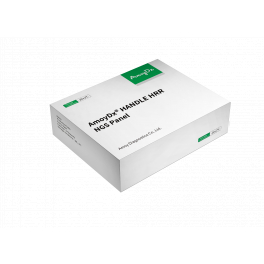 View full size
View full size
- Analýza nukleových kyselin
- Analýza proteinů
- Biochemické reagencie
- Enzymy
- Editování genů
- Klonování
- Klinická diagnostika
- STR kity - identifikace osob, určení otcovství a příbuznosti
- Laboratorní příslušenství
- Software
- A&A Biotechnology
- AdvancedSeq
- BioDynami
- Plant Cell Technology
Novinky
-
XXXV. Izakovičov memoriál 2025
S potěšením oznamujeme, že se zúčastníme prestižní konference XXXV. Izakovičov memoriál 2025, která se bude konat 8.–10. října 2025 v Grandhotelu Praha v Tatranské Lomnici na Slovensku. Izakovičov me...
Více -
1.československý kongres lékařské genetiky 2025
Na jaře se zúčastníme 1. československého kongresu lékařské genetiky, který se bude konat 2.-4. dubna 2025 v Kulturním a kongresovém centru Elektra v lázeňském městě Luhačovice. Tento jedinečný kong...
Více -
RANK 2025
Navštivte nás na 19. ročníku konference RANK 2025, která se koná 19. a 20. března v hotelu Zlatá Štika v Pardubicích. Konferenci pořádá Česká společnost klinické biochemie při ČLSJEP ve spolupráci s ...
Více
 View full size
View full size
Background
The Homologous Recombination Repair (HRR) pathway plays an important role in double strand break, which is the major cause of cancer development. It has been demonstrated that loss of function of HRR genes (e.g. BRCA1, BRCA2, PALB2) and Homologous Recombination Deficiency (HRD) will cause a higher risk of developing cancer, and patients with HRR gene mutations showed higher response to PARPi and platinum-containing therapies.
Intended Use
The AmoyDx® HANDLE HRR NGS Panel (Reversible Terminator Sequencing), is intended for qualitative detection of AR, ATM, ATR, BARD1, BRCA1, BRCA2, BRIP1, CDH1, CDK12, CHEK1, CHEK2, ESR1, FANCA, FANCL, HDAC2, HOXB13, MRE11A, NBN, PALB2, PPP2R2A, PTEN, RAD51B, RAD51C, RAD51D, RAD54L, STK11 and TP53 variants (in coding exons and exon-intron boundaries) and hotspots of gene BRAF, ERBB2, KRAS, NRAS and PIK3CA in extracted DNA from human blood samples, fresh tissue or neutral formalin-fixed paraffin-embedded (FFPE) tissue samples. The detected variants include point mutations, small insertions and deletions in HRR genes.
The kit is for research use only, and intended to be used by trained professionals in a laboratory environment.
Principles of the Procedure
The test kit is based on Halo-shape ANnealing and Defer-Ligation Enrichment system (HANDLE system) technology which is improved Molecular Inversion Probe (MIP) technology to capture the target gene region (Figure 1). The unique molecular identifier (UID) is introduced to both end of each DNA fragment, and tracing back to original template for error correction. The library construction time of HANDLE system is 5 hours with 1 hour hands-on time. After quality control (QC), the prepared DNA libraries are sequenced on Illumina sequencing platform to detect the mutations from 32 HRR related genes mentioned above.
The probe contains an extension arm and a ligation arm which are complementary to the target gene region. First, the extension arm and ligation arm are anchored to the target gene region, and the DNA is extended from the extension arm to the ligation arm by the function of DNA polymerase. Next, the nicks are connected with the ligase to generate the circular products. The remaining linear probes, single-strand and double-strand nucleic acid are digested with the exonuclease. Finally, the universal PCR amplification is performed to enrich the target libraries.
Košík
Platební brána



